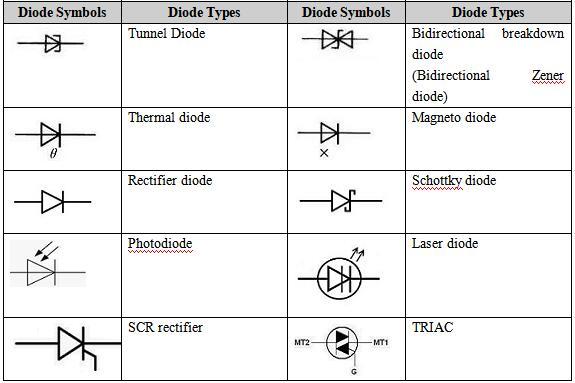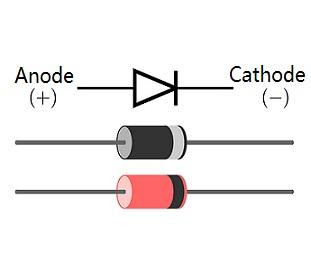As we all know, diodes are drawn on schematics by a standard symbol below that shows how the diode should be installed in circuits. However, do you know that different diodes have different symbols. Here introduces common diodes symbols with short words details about them.


A diode is an electronic device made of semiconductor materials (silicon, selenium, germanium, etc.). It has unidirectional conductivity, that is, when a forward voltage is applied to the anode and cathode of it, the diode is turned on. When a reverse voltage is applied to the anode and cathode, the diode is turned off. Therefore, the diode is equivalent to a switch.
Junction field-effect transistor (JFET) not only has the advantages of small size, light weight, low power consumption, and long life of bipolar transistors, but also has the characteristics of high input resistance, good thermal stability, strong radiation resistance, low noise, etc. Its manufacturing process is simple and it is easy to integrate. Therefore, it has been widely used in large-scale and very large-scale integrated circuits. According to the structure and working principle, field effect transistors(FETs) can be divided into two categories: Junction field effect transistors (JFET) And insulated gate field effect transistor (IGFET).
Light-emitting diodes (LED) are commonly used light-emitting devices that emit energy through the recombination of electrons and holes to emit light. They are widely used in the field of lighting. LED can efficiently convert electrical energy into light energy, and have a wide range of uses in modern society, such as lighting, flat panel displays, and medical devices.
The photodiode is a sensor device that converts light signals into electrical signals. The photodiode works under the action of reverse voltage. When there is no light, the reverse current is extremely weak, called dark current. When there is light, the reverse current rapidly increases to tens of microamperes, called photocurrent. The greater the intensity of light, the greater the reverse current. The change of light causes the current of the photodiode to change, which can convert the light signal into an electrical signal.
A PNP transistor is a bipolar junction transistor made by one n-type material is doped with two p-type materials. It is used to source current, in other words, it is controlled by the current. In a PNP transistor, the majority charge carriers are holes.
A NPN transistor is a bipolar junction transistor made by one p-type material is doped with two n-type materials. It uses both electrons and electron holes as charge carriers, and the majority charge carriers are electrons.
Zener diode uses its PN junction reverse breakdown state, its current can be changed in a wide range while the voltage is basically unchanged. It is mainly used as a voltage regulator or voltage reference component.
Varistor diodes, also known as "voltage-dependent resistor (VDR)", are made by using the characteristic that the junction capacitance changes with the applied voltage when the PN junction is reverse biased. When the reverse bias voltage increases, the junction capacitance decreases, on the contrary, the junction capacitance increases. The capacitance of the it is generally small, and its maximum value is tens of pF to hundreds of pF, and the ratio of the maximum capacitance to the minimum capacitance is about 5: 1. It is mainly used for automatic tuning, frequency modulation, and equalization in high-frequency circuits, for example, as a variable capacitor in the tuning loop of a television receiver.
Bridge rectifier is the most commonly used device for rectification using its unique unidirectional conductivity, and is often used to convert alternating current to direct current.
A tunnel diode or Esaki diode that can be switched at a high speed, which can reach the range of microwave frequencies. The principle is to use the quantum mechanical effect. It is a crystal diode with tunnel effect current as the main current component.
Switching diodes are a type of semiconductor diodes, which are specially designed and manufactured for "on" and "off" on the circuit. The turn-on time required for it is shorter than that of ordinary diodes. The common series are 2AK, 2DK and others, which are mainly used in electronic computers, pulse and switch circuits.
The rectifier diode is a semiconductor device that converts AC power into DC power. Usually it contains a PN junction with two terminals, anode and cathode, and is a vital component in power supplies where they are used to convert AC voltage to DC voltage.
The Schottky diode, also called Schottky barrier diode or hot-carrier diode, are used for their low turn-on voltage, fast recovery time and low-loss energy at higher frequencies. When it is in unbiased condition, the electrons lying on the semiconductor side have a very low energy level compared to the electrons present in the metal.
A laser diode, injection laser diode, or diode laser is similar to a LED in which a diode pumped directly with electrical current can create lasing conditions at the diode's junction. It includes single heterojunction (SH), double heterojunction (DH) and quantum well (QW) laser diodes.
A silicon controlled rectifier (SCR) or semiconductor controlled rectifier, also known as the thyristor, is a four-layer solid-state current-controlling device, NPNP or PNPN. When a gate pulse is applied to it, just like a diode. SCRs are unidirectional devices as opposed to TRIACs.

